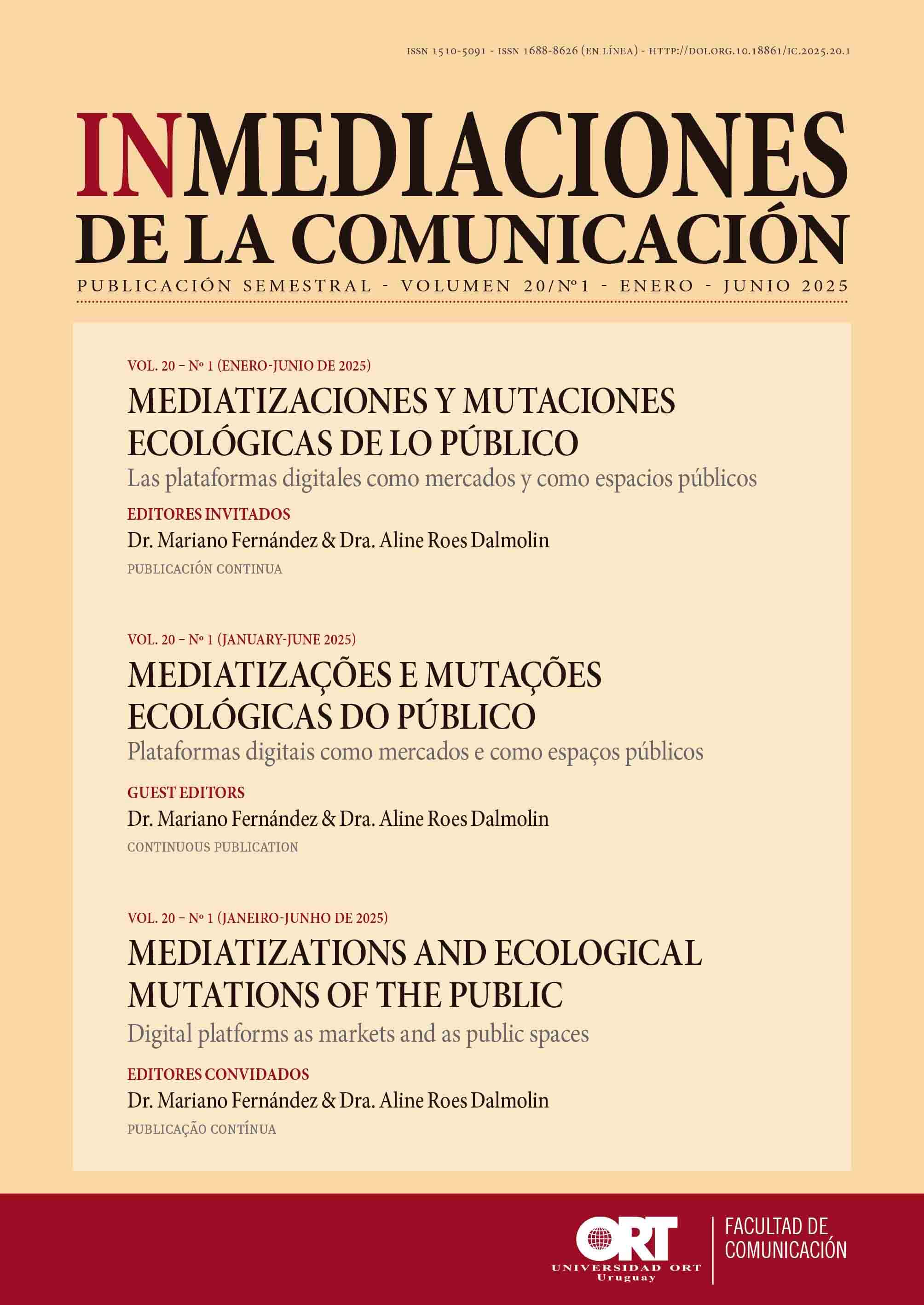There was a time that was
On retro and video game returns to the past
DOI:
https://doi.org/10.18861/ic.2025.20.1.4020Keywords:
video game, retro, sociosemiotics, genre, styleAbstract
This article approaches video games, their products and social practices from a socio-semiotic perspective, focusing on the modes of behavior of the sense associated with retro. The research that appeared in the field of game studies approached the issue of retro mostly from the category of nostalgia and have taken celebratory or lapidary positions that did not advance the understanding of the phenomenon. Here we propose an analysis that examines the functioning of stylistic taxonomies, the self-consciousness of some genres with regard to their own history and the attempt to restore playful experiences attached to old devices. The article proposes an approach to retro following the concepts of style, genre and device. This segmentation of the question around the references to the past reveals that retro can exhibit different semiotic functions depending on the dimension observed: stylistic taxonomies such as 8-bit or CGA promise a return to a technological moment, even if their reference systems concentrate on a delimited corpus of games and expressive operations; the nostalgic survival of a specific genre such as fighting games evidences a tension between audiovisual modernization and the insistence on old tactile pleasures; and the launching of new games for old consoles confirms that the enjoyment of video games is not restricted to their diegetic worlds, but also extends to the device and paratexts (such as boxes and manuals) that have accompanied the life of the medium and its consumption since its origins.
Downloads
References
Aumont, J. (2013). La imagen. Paidós.
Bogost, I, Ferrari, S. & Schweizer, B. (2010). Newsgames: Journalism at play. MIT Press.
Bogost, I. (2007). Persuasive games: Videogames and procedural rhetoric. MIT Press.
Boyer, M. (2019). Video Games & Nostalgia: An Intertwined Relationship. Game Developer. https://www.gamedeveloper.com/design/video-games-nostalgia-anintertwined-relationship
Campi, I. (2007). Diseño y nostalgia. El consumo de la historia. Belloch/Santa & Cole.
Carbo-Mascarell, R. (2016) Walking simulators: The digitisation of an aesthetic practice. DIGRA Digital Library. https://dl.digra.org/index.php/dl/article/view/807/807
Clarke, A. & Mitchell, G. (comp). (2013). Videogames and art. Intellect.
Danto, A. (2009). Después del fin del arte. Paidos.
Esposito, N. (2005). How Video Game History Shows Us Why Video Game Nostalgia Is So Important Now. Conference: Playing the Past. https://www.researchgate.net/publication/215673474_How_Video_Game_History_Shows_Us_Why_Video_Game_Nostalgia_Is_So_Important_Now
Fisher, M. (2013). Los fantasmas de mi vida. Escritos sobre depresión, hauntología y futuros perdidos. Caja Negra.
Genette, G. (2001). Umbrales. Siglo XXI.
Gilbert, A. (2017). Crowdfunding Nostalgia: Kickstarter and the Revival of Classic Pc Games Genres. Comput Game Journal, 6, 17-32. https://link.springer.com/article/10.1007/s40869-017-0031-x
Heineman, D. (2014). Public Memory and Gamer Identity: Retrogaming as Nostalgia. Journal of Games Criticism, 1(1), 1-24. https://www.google.com/search?client=firefox-b-d&q=Heineman%2C+D.+%282014%29.+Public+Memory+and+Gamer+Identity%3A+Retrogaming+as+Nostalgia
Jameson, F. (1999). El giro cultural. Escritos seleccionados sobre el posmodernismo 1983-1998. Manantial.
Kirkpatrick, G. (2011). Aesthetic theory and the video game. Manchester University Press.
Latypova, A. & Lenkevich, A. (2018). From the Inside of the Medium: Analytics of Retro Games. DIGRA Digital Library. https://dl.digra.org/index.php/dl/article/view/1035
Malberg, E. (2014). Shovel Knight Review. PC Gamer. https://www.pcgamer.com/shovel-knight-review/
Maté, D. (2021). Notas para una periodización del videojuego. Cuadernos del Instituto. Investigación y Experimentación en Arte y Crítica, (6), pp. 6-20.
Mc Shea, T. (2015). Shovel Knight Review. Gamespot. https://www.gamespot.com/reviews/shovel-knightreview/1900-6415805/
McElroy, G. (2014). Shovel Knight Review: Rewrite History. Polygon. https://www.polygon.com/2014/6/26/5842180/shovel-knight-review-pc-3ds-wii-u
Metz, C. (1990). L’énonciation impersonnelle, ou le site du film. Méridien-Klincksieck.
Planells de la Maza, A. (2013). Arte pixelado, nostalgia y géneros perdidos: “Resonance” o el resurgir de la aventura gráfica clásica. ArDin. Arte, Diseño e Ingeniería, 2, 8-15. https://polired.upm.es/index.php/ardin/article/view/2093
Reynolds, S. (2012). Retromanía. La adicción del pop a su propio pasado. Caja Negra.
Ruiz Cañero, A. (2019). Cuphead, otro paradigma de lo retro en los videojuegos. AACA Digital. Revista de la Asociación Aragonesa de Críticos de Arte, 48. https://www.aacadigital.com/contenido.php?idarticulo=1577
Schrank, B. (2014). Avant-garde videogames. MIT Press.
Sharp, J. (2015). Works of Game: On the Aesthetics of Games and Art. MIT Press.
Sloan, R. (2016). Nostalgia Videogames as Playable Game Criticism. GAME. The Italian Journal of Game Studies, 5. https://www.gamejournal.it/sloan-nostalgia-videogames/
St1ka (2019). Tanglewood Game Review. YouTube. https://www.youtube.com/watch?v=vXvOpzsdeVo
Steimberg, O. (2013). Semióticas. Las semióticas de los géneros, los estilos, de la transposición. Eterna Cadencia.
Tanner, G. (2024). Porsiemprismo. Cuando nada termina nunca. Caja Negra.
Traversa, O. (2014). Inflexiones del discurso. Cambios y rupturas en las trayectorias del sentido. Santiago Arcos.
Venegas Ramos, A. (2018). Retrolugares, definición, formación y repetición de lugares, escenarios y escenas imaginados del pasado en la cultura popular y el videojuego. Revista de historiografía, 28, 323-346. https://doi.org/10.20318/revhisto.2018.4225
Verón E. (1998). La semiosis social. Gedisa.
Verón E. (2005). Cuando leer es hacer: la enunciación en la prensa gráfica. En Fragmentos de un tejido (pp. 171-191). Gedisa.
Wilson, L. (2019). Story analysis: Evoland. Games & Stories. https://gamesandstories.home.blog/2019/10/02/story-analysis-evoland/
Wulf, T., Bowman, N., Rieger, D., Velez, J. & Breuer, J. (2018). Video Games as Time Machines: Video Game Nostalgia and the Success of Retro Gaming. Media and Communication, 6(2), 60-68. https://www.cogitatiopress.com/mediaandcommunication/article/view/1317






